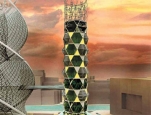High-Rise Beehive

Tall Buildings have been one of the most prominent symbols of economic growth for nearly a century. Yet, in the aftermath of the tragedies of September 11, “signature” Tall buildings have become the focus of much debate. The structural systems today are undergoing a major evolution to address the ability of providing flexibility in the design and use of the building together with sustainability (Green) and cost-effective system.
This paper describes a new invented structural system, evolutionary structural analysis and design of Tall buildings, which involves the entire analysis process, including conceptual and design stages and comparison with the existing Tall building. This study presents an new innovative structural system, Beehive (Hexagrid ), for Tall buildings. The final results are achieved by modeling an 80 story Tall building with the optimized angle and topology of hexagon members by using a computer analysis, ETABS finite element analysis.
The objective function of this system is to use one structural system in order to both maximize Eigen frequency for resisting dynamic responses and minimize mean compliance for static responses. Finite element analysis is carried out by using standardized materials. Optimal Hexagrid topologies with the highest stiffness are finally determined to resist both static and dynamic behaviors. Holistic design integration approaches between structures and facades to save energy for environmental control are studied. Innovative design ideas to control structural motion as well as to utilize that motion to harness energy are discussed. Considering abundant emergence of tall buildings all over the world in recent years, the importance of the studies presented in this paper cannot be overemphasized for constructing more sustainable built environments.
Introduction
Tall buildings have great potential of creating sustainable built environments by their own nature. Compared with the cities with low-rise buildings, those with tall buildings use land more efficiently. Early designs of tall buildings recognized the effectiveness of diagonal bracing members in resisting lateral forces. Most of the structural systems deployed for early tall buildings were steel frames with diagonal bracings of various configurations such as X, K, and chevron. A major point of this design approach is to introduce a new structural system for Tall building.
The hexagonal and diamonds were located along the entire exterior perimeter surfaces of the building in order to maximize their structural effectiveness and capitalize on the aesthetic innovation. This strategy is much more effective than confining diagonals to narrower building cores. In the hexagrid structure system, almost all the conventional vertical columns are eliminated. Our approach is to define a unique structural system for Tall building in order to minimize additional system for lateral loads (lateral system).
In this system (Beehive), members in hexagrid structural systems can carry gravity loads as well as lateral forces due to their hexagonized configuration in a distributive and uniform manner. Compared with other systems in Tall buildings, hexagrid structures are much more effective in minimizing shear deformation because they carry shear by axial action of the diagonal members, while other structures carry shear by the bending of the vertical columns and horizontal spandrels. The hexagrid structure provides both bending and shears rigidity and does not need high shear rigidity cores because shear can be carried by the Hexagon and diamond elements located on the perimeter.
Full version you can download here
 New Innovated Structural System for Tall Buildings
New Innovated Structural System for Tall Buildings
Text by Dr. Peyman A. Nejad ,
Director of Structural Engineering, TJEG International, SF,
USA and CTB UH’s Country Leader, Chicago, USA


